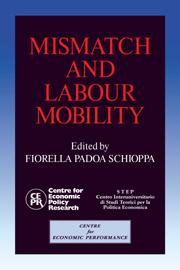Book contents
- Frontmatter
- Contents
- List of figures
- List of tables
- Preface
- Acknowledgements
- List of conference participants
- 1 A cross-country comparison of sectoral mismatch in the 1980s
- 2 Mismatch: a framework for thought
- Discussion
- 3 Match and mismatch on the German labour market
- Discussion
- 4 Mismatch in Japan
- Discussion
- 5 Mismatch and internal migration in Spain, 1962–86
- Discussion
- 6 Regional inequalities, migration and mismatch in Italy, 1960–86
- Discussion
- 7 Skill shortages and structural unemployment in Britain: a (mis)matching approach
- Discussion
- 8 Labour market tightness and the mismatch between demand and supply of less-educated young men in the United States in the 1980s
- Discussion
- 9 Skill mismatch, training systems and equilibrium unemployment: a comparative institutional analysis
- Discussion
- 10 Unemployment, vacancies and labour market programmes: Swedish evidence
- Discussion
- 11 Mismatch and labour mobility: some final remarks
- Index
Discussion
Published online by Cambridge University Press: 05 October 2010
- Frontmatter
- Contents
- List of figures
- List of tables
- Preface
- Acknowledgements
- List of conference participants
- 1 A cross-country comparison of sectoral mismatch in the 1980s
- 2 Mismatch: a framework for thought
- Discussion
- 3 Match and mismatch on the German labour market
- Discussion
- 4 Mismatch in Japan
- Discussion
- 5 Mismatch and internal migration in Spain, 1962–86
- Discussion
- 6 Regional inequalities, migration and mismatch in Italy, 1960–86
- Discussion
- 7 Skill shortages and structural unemployment in Britain: a (mis)matching approach
- Discussion
- 8 Labour market tightness and the mismatch between demand and supply of less-educated young men in the United States in the 1980s
- Discussion
- 9 Skill mismatch, training systems and equilibrium unemployment: a comparative institutional analysis
- Discussion
- 10 Unemployment, vacancies and labour market programmes: Swedish evidence
- Discussion
- 11 Mismatch and labour mobility: some final remarks
- Index
Summary
This study is packed with information and provides a very interesting read.
My main reservation, however, concerns the definition of ‘mismatch’ that is adopted. On the study's definition, differences in unemployment rates between regions that are permanent would not count, as they are said to arise from differences in amenities. It is, however, by no means clear that an amenities-based explanation of permanent unemployment differences is plausible. To make the point in a stark fashion, the unemployment rate in Northern Ireland has consistently exceeded that in South-East England for at least 60 years: an amenities-based ‘explanation’ of this fact would actually have to argue that Northern Ireland is more congenial to live in, as compared to South-East England.
There are alternative theoretical models to account for relatively persistent unemployment differences. A labour market where ‘insiders’ are powerful provides one such example. The model contained in Jackman et al. (1990), is able to account for permanent differences in unemployment rates in terms of differences in population and/or employment growth. Since most of the dispersion in regional unemployment rates is relatively permanent (on the author's estimates, in Japan 95% of the variation in relative unemployment rates is permanent), it is important to study, and explain, them. The author might contend that ‘mismatch’ refers only to transitory differences. However, if we accept that definition then, given the relative insignificance of such transitory differences, ‘mismatch’ becomes a much less interesting subject of inquiry.
- Type
- Chapter
- Information
- Mismatch and Labour Mobility , pp. 179 - 181Publisher: Cambridge University PressPrint publication year: 1991



